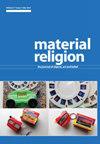Apocalyptic Geographies: Religion, Media, and the American Landscape
IF 0.4
3区 哲学
0 RELIGION
引用次数: 0
Abstract
117 strate how Tibetan texts become more sacred through ritualised interactions. The chapter by Yohan Yoo examines how Neo-Confucian scholars from the twelfth and sixteenth centuries promoted sensory readings of scriptures to facilitate religious experiences ‘in which they could see the sages and hear their voices’ (162). Yoo shows that the senses were inherent to the practice of reading Confucian scriptures, and highlights the need for further study in this area. The final chapter of the collection, by James W. Watts, brings together the study of these different ritualistic traditions. Watts uses Charles Pierce’s Sign Theory to explore the indexical relationship between sacred books and their users. In addition, he draws on Roy Rappaport’s theory of ritual to demonstrate that holding or touching sacred scriptures ‘indexes’ a person’s religious identity. Watts also examines how such veneration can ‘manifest itself in a refusal to touch scripture’ (178), such as the handing of the Torah in antiquity and traditional Jewish practices. He concludes his chapter with an investigation of the representations of scribes, professors, and deities holding books, and the observation that touching and holding sacred books enables people to ‘feel like they can touch divinity’ (183). The collection of essays demonstrates the intrinsic relationship between the senses and sacred texts, highlighting the importance for further study in this area. Sensing Sacred Texts provides a fascinating array of studies from a wide range of religious traditions and historical periods. The broad contributions will be of interest to scholars working in a variety of fields, especially those of religion, materiality, art history, as well as ritual and performative studies.《启示录地理学:宗教、媒体和美国景观》
117展示了藏文如何通过仪式化的互动变得更加神圣。Yohan Yoo撰写的这一章研究了12世纪和16世纪的新儒家学者如何促进对经文的感官阅读,以促进宗教体验,“他们可以看到圣人并听到他们的声音”(162)。他指出,感官是阅读儒家经文的固有习惯,并强调了在这一领域进行进一步研究的必要性。詹姆斯·w·沃茨(James W. Watts)撰写的文集的最后一章,汇集了对这些不同仪式传统的研究。瓦茨使用查尔斯·皮尔斯的符号理论来探索圣书和他们的用户之间的索引关系。此外,他还借鉴了罗伊·拉帕波特(Roy Rappaport)的仪式理论来证明,持有或触摸神圣的经文“表明”了一个人的宗教身份。瓦茨还研究了这种崇敬如何“表现为拒绝触摸经文”(178),比如古代的托拉和传统的犹太习俗。在这一章的结尾,他调查了文士、教授和神拿着书的表现,并观察到触摸和拿着圣书可以让人们“感觉他们可以触摸到神”(183)。论文集论证了感官与神圣文本之间的内在联系,强调了这一领域进一步研究的重要性。感应神圣文本提供了一个迷人的研究阵列从广泛的宗教传统和历史时期。这些广泛的贡献将引起各个领域的学者的兴趣,特别是那些宗教、物质性、艺术史以及仪式和表演研究的学者。
本文章由计算机程序翻译,如有差异,请以英文原文为准。
求助全文
约1分钟内获得全文
求助全文

 求助内容:
求助内容: 应助结果提醒方式:
应助结果提醒方式:


